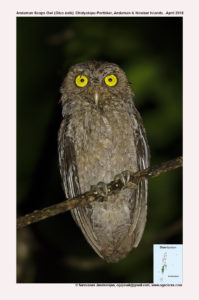
Andaman Scops Owl Otus balli
Etymology:
- Otus : Latin word for eared Owl
- Balli : Named after Irish naturalist Ball (1843–1895)
Distribution in India: Resident of Andaman Islands in India.
Description: Size of 18–19 cm. It occurs in rufous and grey-brown morphs, former less variegated. It has fairly prominent ear-tufts and pale eyebrows. The upperparts are sparsely peppered with black and whitish spots, numerous white spots on crown and neck that resemble a collar. The flight-feathers are barred white, brown and tan, tail is barred brown and tan. The underparts are much paler and greyer than upperparts, chest is finely vermiculated, with thin black spots throughout; iris is yellow, hazel or brown; bill is yellow or greenish-horn; tarsus is bare for third to half its length; feet are flesh-grey to greenish-yellow. It has rougher plumage texture, relatively more conspicuous black and white flecking over plumage and lack of pale scapular stripe.
Habitat: It is found in trees in semi-open areas, settlements and cultivated areas; gardens; has been known to enter bungalows.
Food habits: It eats arthropods likecaterpillars, also beetles and other insects. It captures caterpillars from foliage by sidling up to them in a parrot-like fashion. It is strictly nocturnal.
Breeding habits: They breed in Feb–Apr. They nest in natural tree hollow or in abandoned hole of woodpecker or barbet. They lay a clutch of 2–3 eggs.